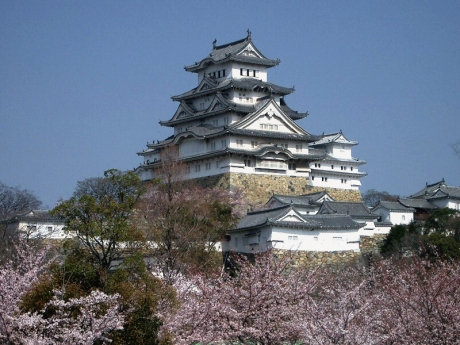Hanami
April 12, 2011
These days cherry blossoms are blooming – not only in Japan: today I went and see those in my city; this gave me the hint to write a post on the Japanese custom of Hanami.
Hanami (花見) literally means “flower viewing” and usually refers to cherry blossom (sakura, 桜) viewing.
Sakura is a symbol of Japan; unlike other cherry trees it does not yield fruits and it’s grown only for its beautiful pink flowers.
Cherry blossoms flower at different times throughout Japan, according to the different climates. They start blooming in January in Okinawa, they are at their peak in late March to April in Honsh, and eventually they reach Hokkaido in May.
Evey year the weather bureau announces the blossom forecast (桜前線, sakurazensen ), so that people can plan their flower viewing.
In modern-day Japan, Hanami mostly consists of having an outdoor party beneath the Sakura trees during daytime or at night. Hanami at night is called Yozakura (夜桜, literally “night sakura”). In many places paper lanterns are hung for that purpose.
In places which are especially popular for hanami, such as Ueno park and Aoyama Cemetary in Tokyo, it’s common to reserve a picnic spot in advance, since they are going to be very crowded. Usually, groups spread their picnic sheet early in the morning and either mark it with their name or have one of them positioned there, other friends arriving after work. The new employees are traditionally given this job of sitting all day long to reserve space for the company celebration (those who have seen “Bengoshi no Kuzu” might remember such a scene).
The picnic consists of a wide variety of foods, snack foods and sake or other drinks. The activities often include dancing and karaoke in addition to the cherry blossom viewing.
Among elderly people and those who enjoy a more quiet style of Hanami, Ume (梅, plum blossom) viewing is another popular traditional celebration.
There are two theories on the origin of Hanami.
One of them says it orginates from the ancient court custom of Hana no En (花の宴, literally “flower banquet” ), a sort of elegant amusement among aristocats, who composed Tanka praising the blossoms of Ume tree. Such custom is said to have been practiced at Court from around Na
ra Period (710-784) to Heian Period (794-1185). During the reign of Emperor Saga, Sakura took the place of Ume as a typical flower for this celebration.
The word “Hanami” was first used as a term analogous to cherry blossom viewing in the Heian era novel “Genji monogatari”. Whilst a wisteria viewing party was also described, fro
m this point on the terms “Hanami” was only used to describe cherry blossom viewing.
According to another theory, the origin of Hanami dates back to ancient Japanese rural culture, even before the Nara Period. Sakura trees were very important to the ancient Japanese farmers: they believed that Sagami, a deity who lived in the mountains during the cold winter season, would come down from to temporarily stay in Sakura trees and later move on to the rice fields.
Therefore, the blooming of Sakura trees meant that the deity has arrived. Peasants made offerings of food and Sake, partaking them to share some time with the deity, praying for rich harvest in autumn. It is also said that the farmers divined that year’s harvest with Sakura, regarding when the blossoms fell all at once ephemerally in only a few days as a sign of bad luck.
According to Yoshida Kenko (1283? – 1350?), court Hanami and the Hanami in agricultural communities were different traditions, that later got together to develop into the present one.
During the Kamakura period (1185–1333), some of the court customs, including Hana no en, were handed down to the Samurai families from the court nobles, getting gradually merged with the rural worship of Sagami. The custom got more and more spread during the time and, during Edo period, was encouraged by the Shogunate: Tokugawa Yoshimune had a lot of Sakura trees planted in the suburbs in order to promote tourism and to improve the government’s economical situation in those days.
Traditionally, Hanami is seen as a meditation on life, that such as Sakura is ephemeral even though beautiful. However, most of those who contemplate sakura nowadays are more interested in having fun rather than in thinking to the nature of human life. The teasing proverb “dumplings rather than flowers” (花より団子、 hana yori dango) hints at the real priorities for most cherry blossom viewers, meaning that they care mainly about the food and drinks accompanying a hanami party.
For those of you who are into pop culture, the title of the famous manga/anime “Hana yori dango” stems from this proverb, but it is written as “花より男子” (even though the usual reading of 男子 would be “danshi”), meaning “boys over flowers”.



What a lovely article about a beautiful plant.
The photos are stunning. Thanks for sharing.
Thanks. 🙂
is the cherry tree your photo?
i would like to use it in a photo montage.
Feel free. It’s just a picture from the internet. 🙂
But where did you find it?
I googled “hanami” and looked for images :P. You can also save it from here if you want.
Thanks. I found what looks like the original photo taken by Greg Takayama in the Brooklyn Botanical Gardens. I wanted to give him credit.
Hey, you used a photo of mine WITHOUT PERMISSION. Can you either provide a link back or remove the photo.
The photo is from here:
http://www.gregtakayama.com/hanami-part-3
You used it here:
Sorry, I had just found it via google. I take it off now.